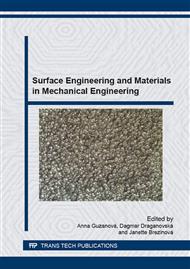p.3
p.7
p.11
p.15
p.19
p.23
p.27
p.32
Formation of the Surface Layers of a Material with Shape-Memory-Based TiNiCo Diffusion Metallization
Abstract:
The formation of a surface layer of diffused TiNiCo was carried out by metallization of fusible metal melt under isothermal conditions in an argon atmosphere at a temperature of 1100–1150 °C. The driving force of the process is the difference in concentration of alloying elements on the surface of the workpiece melt. A melt of lead or eutectic Pb-Bi was used as a transport medium, whose elements are in saturated atomic state and in direct contact with the surface of workpieces. This molten surface-activated product was purified from oxide films, providing a high wettability, which in turn provides good adhesion. Dissolved melt powders of Ti, Ni, and Co were first adsorbed on the surface of the items and then diffused into the surface of the volume. The cementation process was carried out cyclically by lifting the melt products every 25–30 minutes. The duration of the saturation process was 11–13 hours, depending on the desired coating thickness.
Info:
Periodical:
Pages:
3-6
Citation:
Online since:
May 2015
Authors:
Price:
Сopyright:
© 2015 Trans Tech Publications Ltd. All Rights Reserved
Share:
Citation:


